Managerial Accounting Report: Inventory Analysis, Woolworth
VerifiedAdded on 2023/04/24
|6
|1396
|462
Report
AI Summary
This report provides an analysis of managerial accounting practices, specifically focusing on inventory management at Woolworth Limited. The report begins with an introduction to the measurement of inventory, referencing AASB 102 Inventories, and discusses its application in the context of Woolworth's operations. It then delves into the relevant inventory standards maintained by the company, emphasizing the use of the weighted average basis for inventory valuation. The report also identifies the costing system applied by Woolworth Limited, highlighting the use of traditional methods and the potential for adopting an Activity-Based Costing (ABC) system. Furthermore, it examines the influence of costing methods on the company's financial statements, including the classification of costs and the impact on key financial metrics. The report concludes by summarizing the key findings, reiterating Woolworth's adherence to AASB 102 and the potential benefits of adopting a more sophisticated costing approach. The report also includes references to support the analysis.
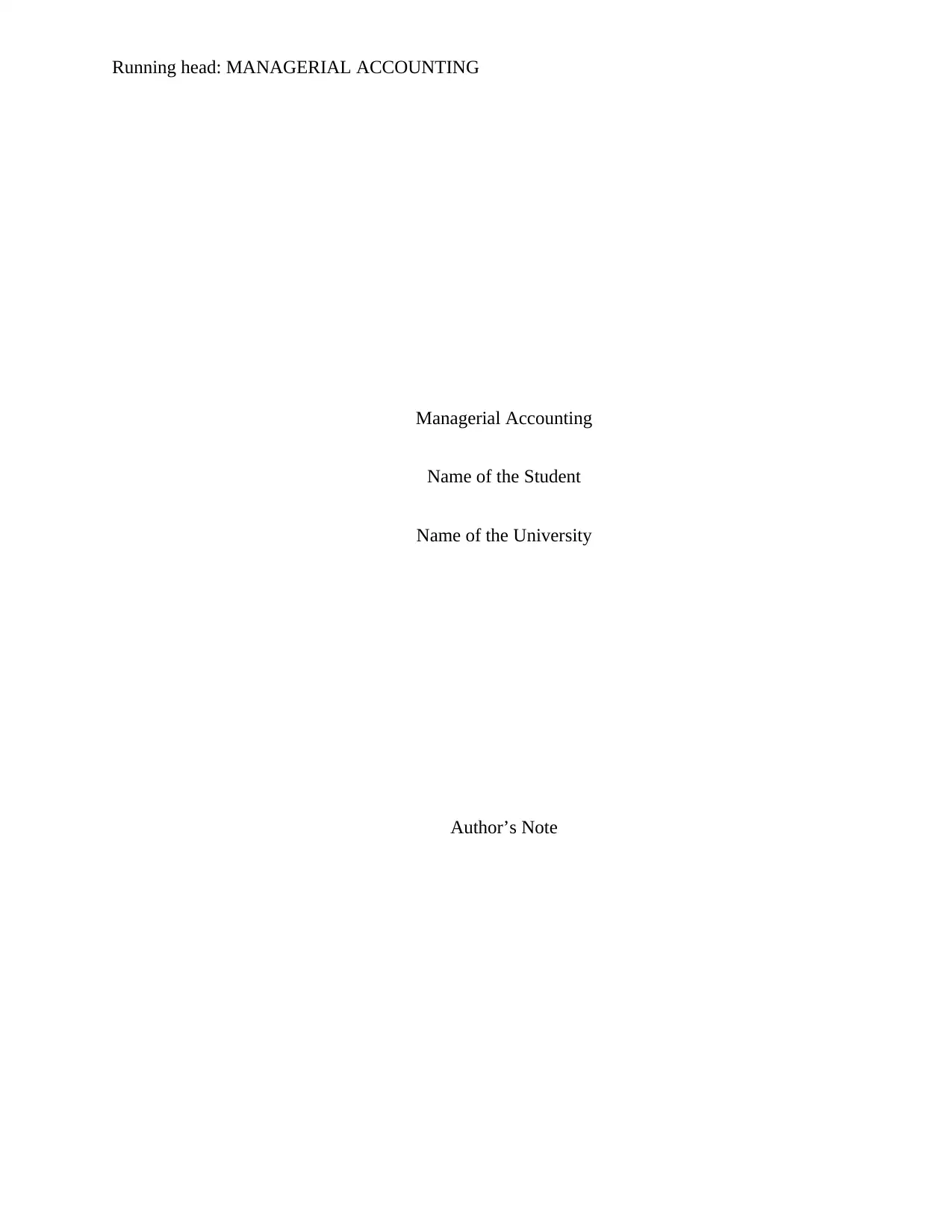
Running head: MANAGERIAL ACCOUNTING
Managerial Accounting
Name of the Student
Name of the University
Author’s Note
Managerial Accounting
Name of the Student
Name of the University
Author’s Note
Paraphrase This Document
Need a fresh take? Get an instant paraphrase of this document with our AI Paraphraser
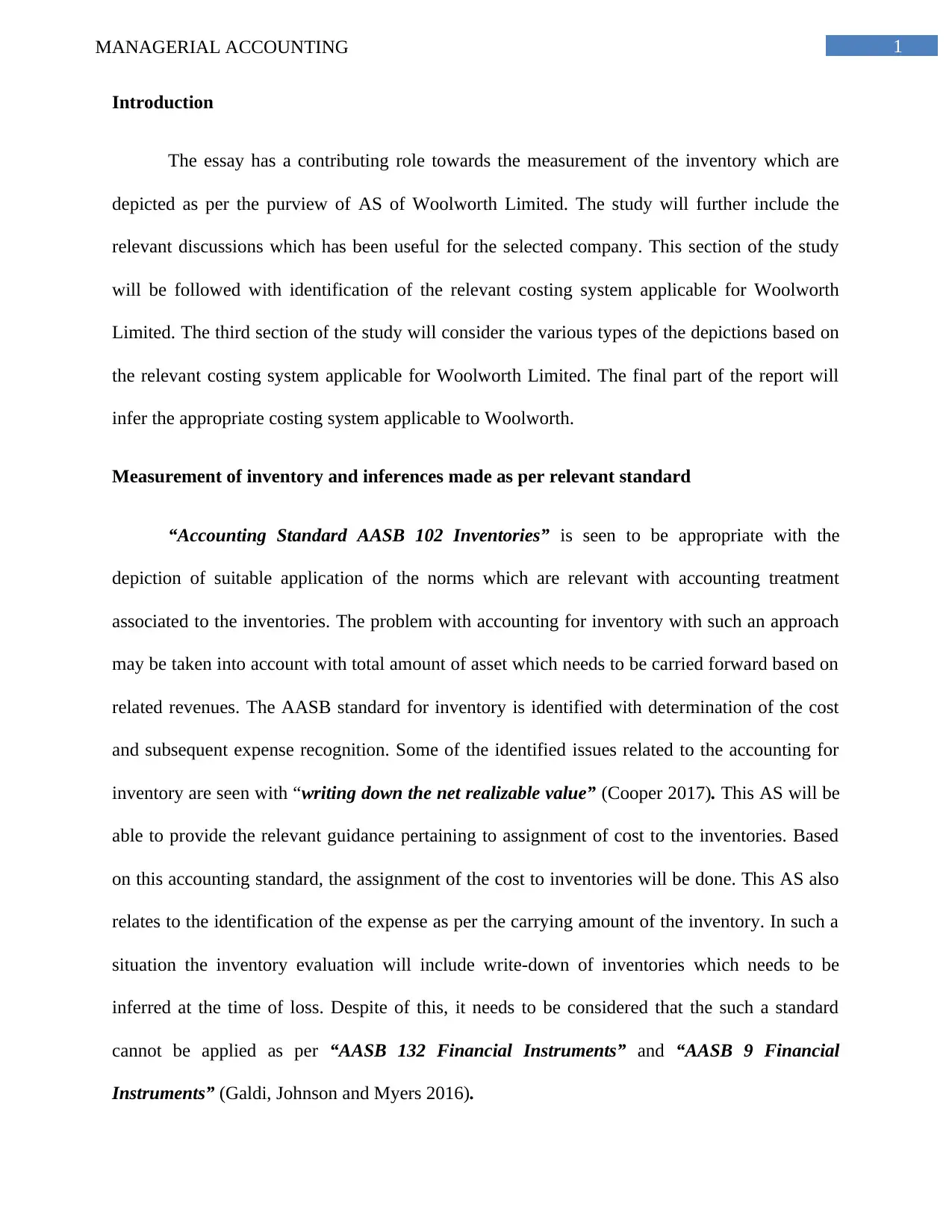
1MANAGERIAL ACCOUNTING
Introduction
The essay has a contributing role towards the measurement of the inventory which are
depicted as per the purview of AS of Woolworth Limited. The study will further include the
relevant discussions which has been useful for the selected company. This section of the study
will be followed with identification of the relevant costing system applicable for Woolworth
Limited. The third section of the study will consider the various types of the depictions based on
the relevant costing system applicable for Woolworth Limited. The final part of the report will
infer the appropriate costing system applicable to Woolworth.
Measurement of inventory and inferences made as per relevant standard
“Accounting Standard AASB 102 Inventories” is seen to be appropriate with the
depiction of suitable application of the norms which are relevant with accounting treatment
associated to the inventories. The problem with accounting for inventory with such an approach
may be taken into account with total amount of asset which needs to be carried forward based on
related revenues. The AASB standard for inventory is identified with determination of the cost
and subsequent expense recognition. Some of the identified issues related to the accounting for
inventory are seen with “writing down the net realizable value” (Cooper 2017). This AS will be
able to provide the relevant guidance pertaining to assignment of cost to the inventories. Based
on this accounting standard, the assignment of the cost to inventories will be done. This AS also
relates to the identification of the expense as per the carrying amount of the inventory. In such a
situation the inventory evaluation will include write-down of inventories which needs to be
inferred at the time of loss. Despite of this, it needs to be considered that the such a standard
cannot be applied as per “AASB 132 Financial Instruments” and “AASB 9 Financial
Instruments” (Galdi, Johnson and Myers 2016).
Introduction
The essay has a contributing role towards the measurement of the inventory which are
depicted as per the purview of AS of Woolworth Limited. The study will further include the
relevant discussions which has been useful for the selected company. This section of the study
will be followed with identification of the relevant costing system applicable for Woolworth
Limited. The third section of the study will consider the various types of the depictions based on
the relevant costing system applicable for Woolworth Limited. The final part of the report will
infer the appropriate costing system applicable to Woolworth.
Measurement of inventory and inferences made as per relevant standard
“Accounting Standard AASB 102 Inventories” is seen to be appropriate with the
depiction of suitable application of the norms which are relevant with accounting treatment
associated to the inventories. The problem with accounting for inventory with such an approach
may be taken into account with total amount of asset which needs to be carried forward based on
related revenues. The AASB standard for inventory is identified with determination of the cost
and subsequent expense recognition. Some of the identified issues related to the accounting for
inventory are seen with “writing down the net realizable value” (Cooper 2017). This AS will be
able to provide the relevant guidance pertaining to assignment of cost to the inventories. Based
on this accounting standard, the assignment of the cost to inventories will be done. This AS also
relates to the identification of the expense as per the carrying amount of the inventory. In such a
situation the inventory evaluation will include write-down of inventories which needs to be
inferred at the time of loss. Despite of this, it needs to be considered that the such a standard
cannot be applied as per “AASB 132 Financial Instruments” and “AASB 9 Financial
Instruments” (Galdi, Johnson and Myers 2016).
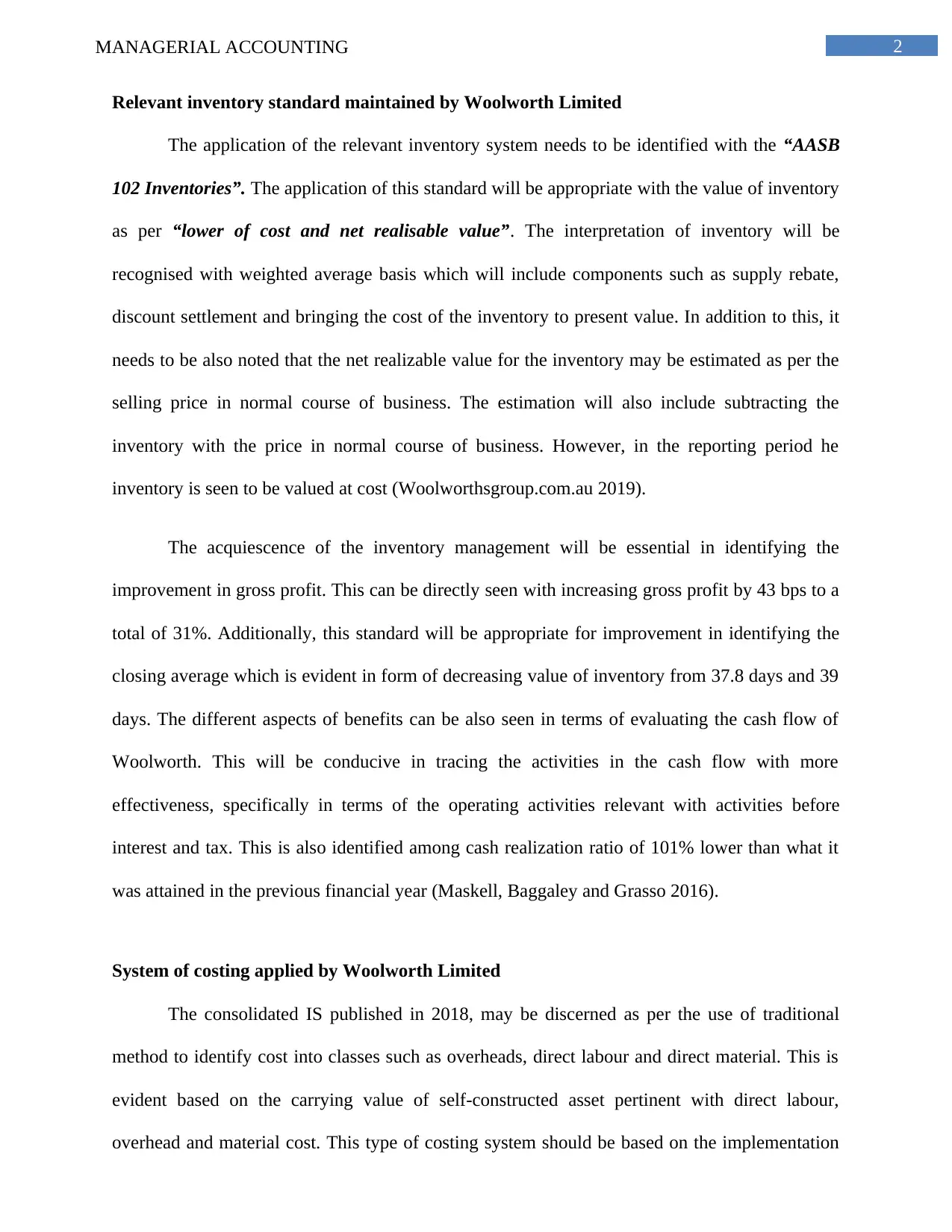
2MANAGERIAL ACCOUNTING
Relevant inventory standard maintained by Woolworth Limited
The application of the relevant inventory system needs to be identified with the “AASB
102 Inventories”. The application of this standard will be appropriate with the value of inventory
as per “lower of cost and net realisable value”. The interpretation of inventory will be
recognised with weighted average basis which will include components such as supply rebate,
discount settlement and bringing the cost of the inventory to present value. In addition to this, it
needs to be also noted that the net realizable value for the inventory may be estimated as per the
selling price in normal course of business. The estimation will also include subtracting the
inventory with the price in normal course of business. However, in the reporting period he
inventory is seen to be valued at cost (Woolworthsgroup.com.au 2019).
The acquiescence of the inventory management will be essential in identifying the
improvement in gross profit. This can be directly seen with increasing gross profit by 43 bps to a
total of 31%. Additionally, this standard will be appropriate for improvement in identifying the
closing average which is evident in form of decreasing value of inventory from 37.8 days and 39
days. The different aspects of benefits can be also seen in terms of evaluating the cash flow of
Woolworth. This will be conducive in tracing the activities in the cash flow with more
effectiveness, specifically in terms of the operating activities relevant with activities before
interest and tax. This is also identified among cash realization ratio of 101% lower than what it
was attained in the previous financial year (Maskell, Baggaley and Grasso 2016).
System of costing applied by Woolworth Limited
The consolidated IS published in 2018, may be discerned as per the use of traditional
method to identify cost into classes such as overheads, direct labour and direct material. This is
evident based on the carrying value of self-constructed asset pertinent with direct labour,
overhead and material cost. This type of costing system should be based on the implementation
Relevant inventory standard maintained by Woolworth Limited
The application of the relevant inventory system needs to be identified with the “AASB
102 Inventories”. The application of this standard will be appropriate with the value of inventory
as per “lower of cost and net realisable value”. The interpretation of inventory will be
recognised with weighted average basis which will include components such as supply rebate,
discount settlement and bringing the cost of the inventory to present value. In addition to this, it
needs to be also noted that the net realizable value for the inventory may be estimated as per the
selling price in normal course of business. The estimation will also include subtracting the
inventory with the price in normal course of business. However, in the reporting period he
inventory is seen to be valued at cost (Woolworthsgroup.com.au 2019).
The acquiescence of the inventory management will be essential in identifying the
improvement in gross profit. This can be directly seen with increasing gross profit by 43 bps to a
total of 31%. Additionally, this standard will be appropriate for improvement in identifying the
closing average which is evident in form of decreasing value of inventory from 37.8 days and 39
days. The different aspects of benefits can be also seen in terms of evaluating the cash flow of
Woolworth. This will be conducive in tracing the activities in the cash flow with more
effectiveness, specifically in terms of the operating activities relevant with activities before
interest and tax. This is also identified among cash realization ratio of 101% lower than what it
was attained in the previous financial year (Maskell, Baggaley and Grasso 2016).
System of costing applied by Woolworth Limited
The consolidated IS published in 2018, may be discerned as per the use of traditional
method to identify cost into classes such as overheads, direct labour and direct material. This is
evident based on the carrying value of self-constructed asset pertinent with direct labour,
overhead and material cost. This type of costing system should be based on the implementation
⊘ This is a preview!⊘
Do you want full access?
Subscribe today to unlock all pages.

Trusted by 1+ million students worldwide
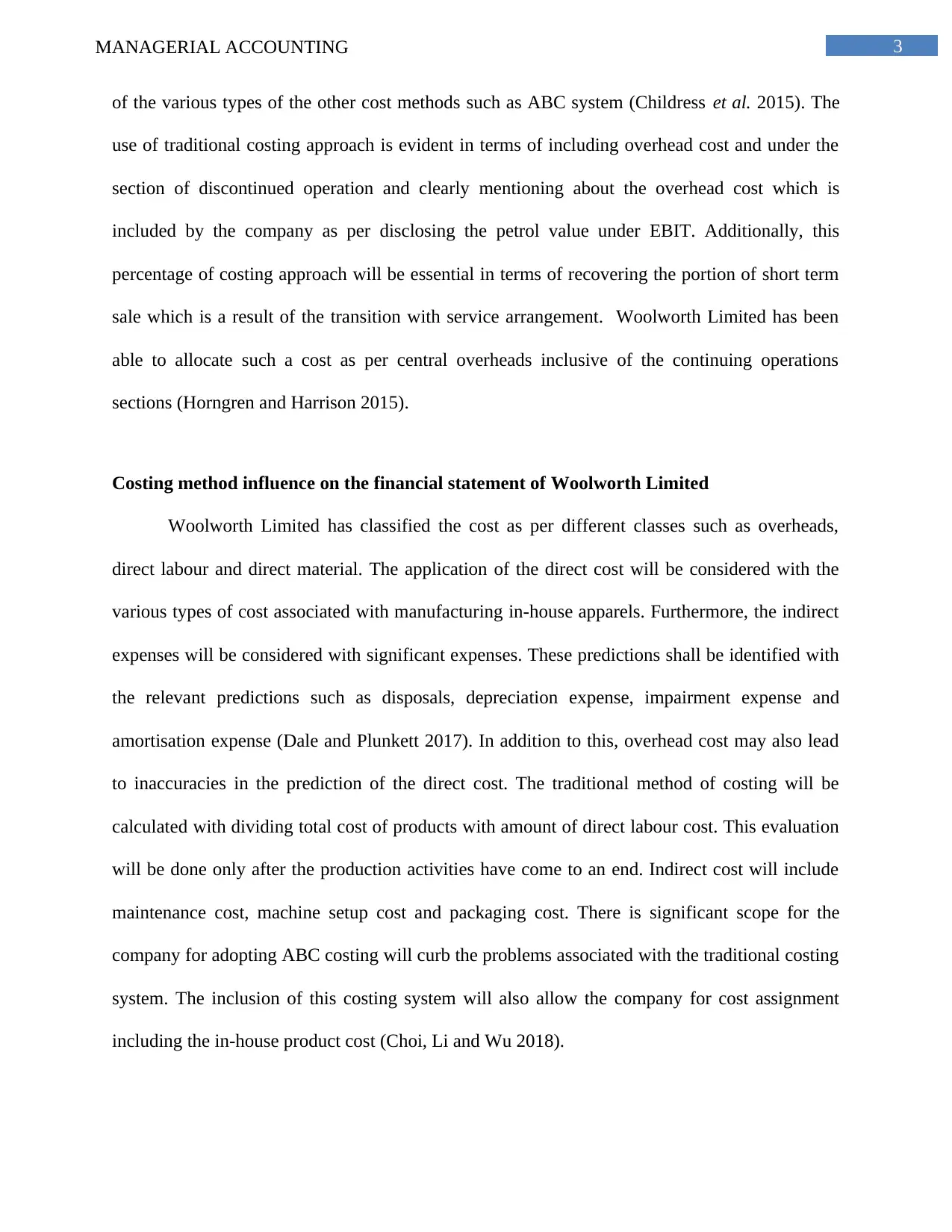
3MANAGERIAL ACCOUNTING
of the various types of the other cost methods such as ABC system (Childress et al. 2015). The
use of traditional costing approach is evident in terms of including overhead cost and under the
section of discontinued operation and clearly mentioning about the overhead cost which is
included by the company as per disclosing the petrol value under EBIT. Additionally, this
percentage of costing approach will be essential in terms of recovering the portion of short term
sale which is a result of the transition with service arrangement. Woolworth Limited has been
able to allocate such a cost as per central overheads inclusive of the continuing operations
sections (Horngren and Harrison 2015).
Costing method influence on the financial statement of Woolworth Limited
Woolworth Limited has classified the cost as per different classes such as overheads,
direct labour and direct material. The application of the direct cost will be considered with the
various types of cost associated with manufacturing in-house apparels. Furthermore, the indirect
expenses will be considered with significant expenses. These predictions shall be identified with
the relevant predictions such as disposals, depreciation expense, impairment expense and
amortisation expense (Dale and Plunkett 2017). In addition to this, overhead cost may also lead
to inaccuracies in the prediction of the direct cost. The traditional method of costing will be
calculated with dividing total cost of products with amount of direct labour cost. This evaluation
will be done only after the production activities have come to an end. Indirect cost will include
maintenance cost, machine setup cost and packaging cost. There is significant scope for the
company for adopting ABC costing will curb the problems associated with the traditional costing
system. The inclusion of this costing system will also allow the company for cost assignment
including the in-house product cost (Choi, Li and Wu 2018).
of the various types of the other cost methods such as ABC system (Childress et al. 2015). The
use of traditional costing approach is evident in terms of including overhead cost and under the
section of discontinued operation and clearly mentioning about the overhead cost which is
included by the company as per disclosing the petrol value under EBIT. Additionally, this
percentage of costing approach will be essential in terms of recovering the portion of short term
sale which is a result of the transition with service arrangement. Woolworth Limited has been
able to allocate such a cost as per central overheads inclusive of the continuing operations
sections (Horngren and Harrison 2015).
Costing method influence on the financial statement of Woolworth Limited
Woolworth Limited has classified the cost as per different classes such as overheads,
direct labour and direct material. The application of the direct cost will be considered with the
various types of cost associated with manufacturing in-house apparels. Furthermore, the indirect
expenses will be considered with significant expenses. These predictions shall be identified with
the relevant predictions such as disposals, depreciation expense, impairment expense and
amortisation expense (Dale and Plunkett 2017). In addition to this, overhead cost may also lead
to inaccuracies in the prediction of the direct cost. The traditional method of costing will be
calculated with dividing total cost of products with amount of direct labour cost. This evaluation
will be done only after the production activities have come to an end. Indirect cost will include
maintenance cost, machine setup cost and packaging cost. There is significant scope for the
company for adopting ABC costing will curb the problems associated with the traditional costing
system. The inclusion of this costing system will also allow the company for cost assignment
including the in-house product cost (Choi, Li and Wu 2018).
Paraphrase This Document
Need a fresh take? Get an instant paraphrase of this document with our AI Paraphraser
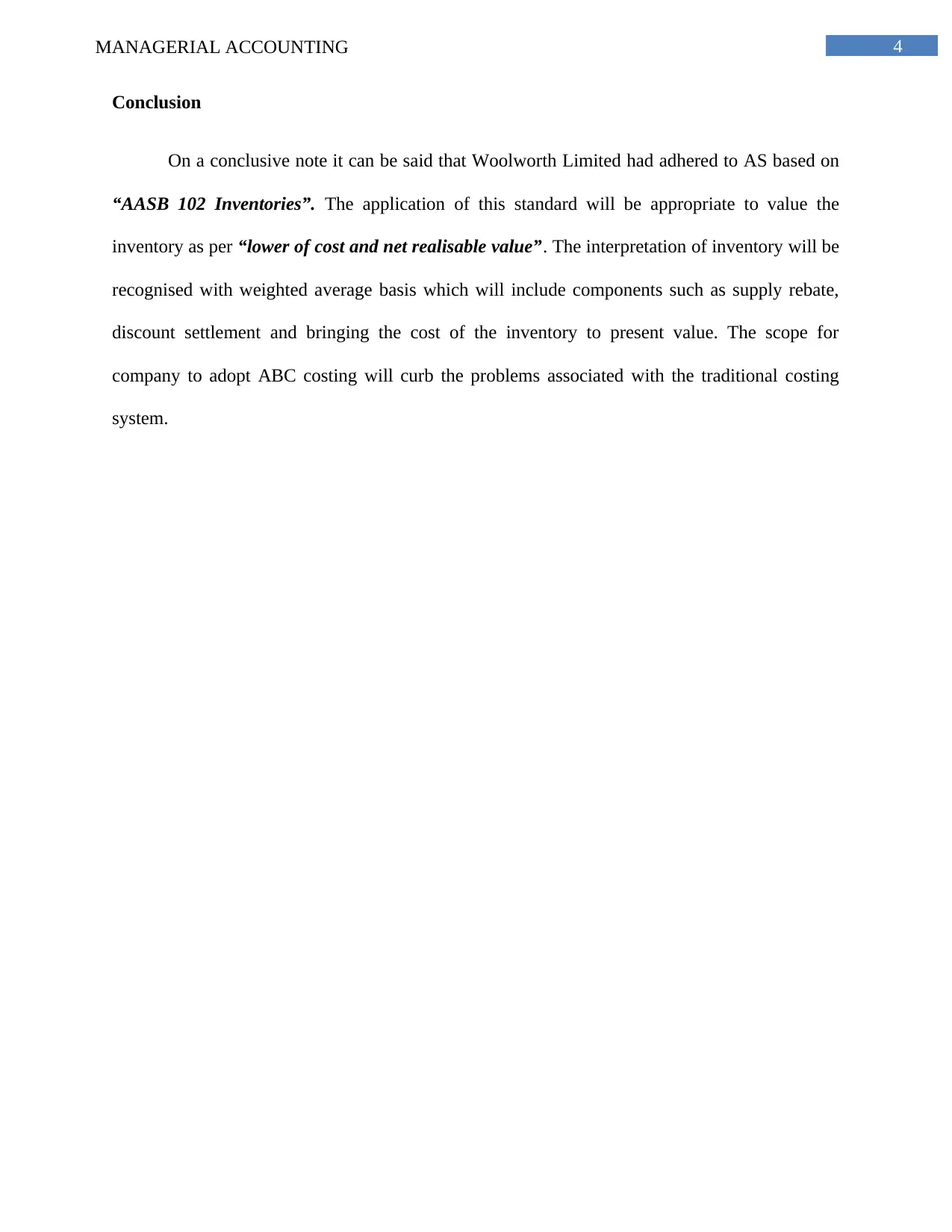
4MANAGERIAL ACCOUNTING
Conclusion
On a conclusive note it can be said that Woolworth Limited had adhered to AS based on
“AASB 102 Inventories”. The application of this standard will be appropriate to value the
inventory as per “lower of cost and net realisable value”. The interpretation of inventory will be
recognised with weighted average basis which will include components such as supply rebate,
discount settlement and bringing the cost of the inventory to present value. The scope for
company to adopt ABC costing will curb the problems associated with the traditional costing
system.
Conclusion
On a conclusive note it can be said that Woolworth Limited had adhered to AS based on
“AASB 102 Inventories”. The application of this standard will be appropriate to value the
inventory as per “lower of cost and net realisable value”. The interpretation of inventory will be
recognised with weighted average basis which will include components such as supply rebate,
discount settlement and bringing the cost of the inventory to present value. The scope for
company to adopt ABC costing will curb the problems associated with the traditional costing
system.
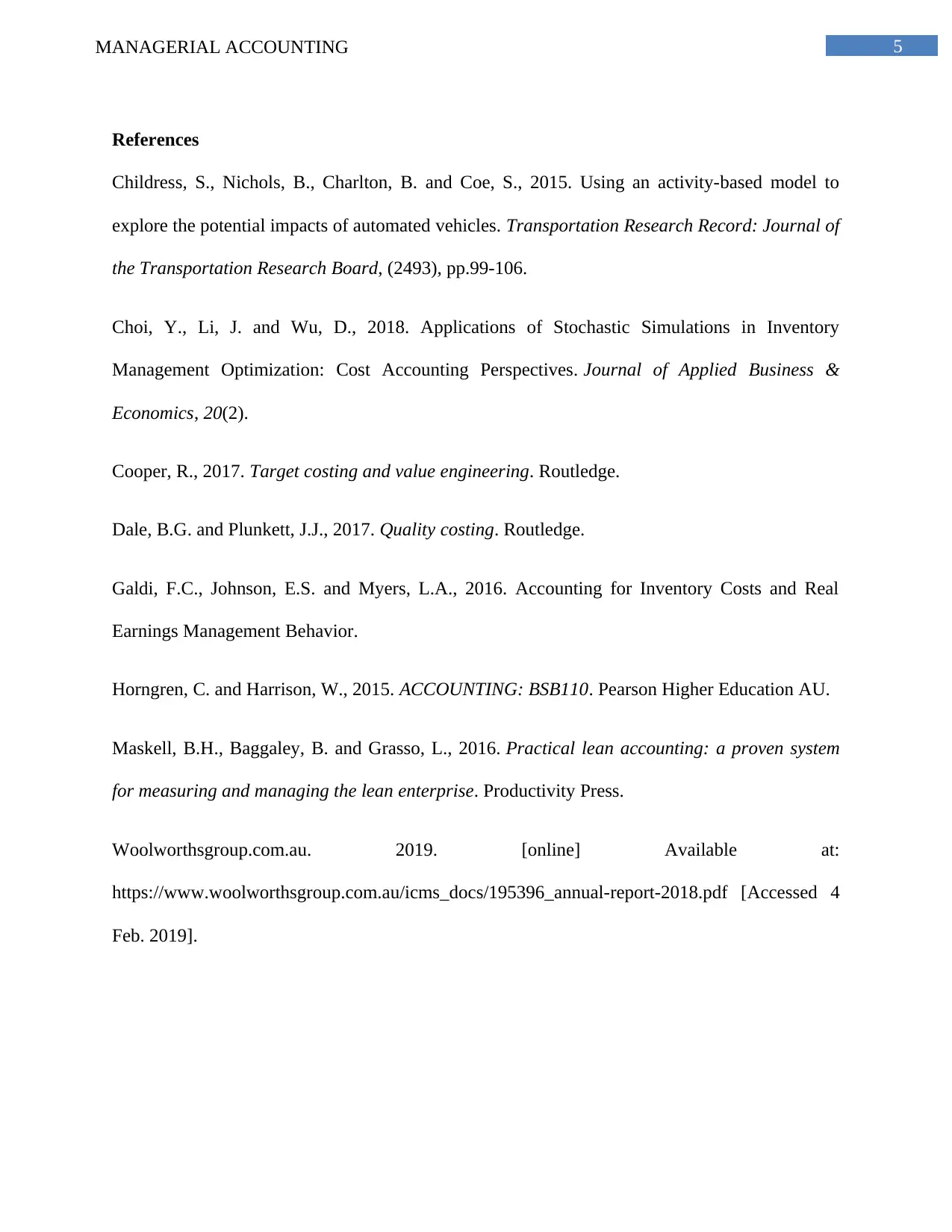
5MANAGERIAL ACCOUNTING
References
Childress, S., Nichols, B., Charlton, B. and Coe, S., 2015. Using an activity-based model to
explore the potential impacts of automated vehicles. Transportation Research Record: Journal of
the Transportation Research Board, (2493), pp.99-106.
Choi, Y., Li, J. and Wu, D., 2018. Applications of Stochastic Simulations in Inventory
Management Optimization: Cost Accounting Perspectives. Journal of Applied Business &
Economics, 20(2).
Cooper, R., 2017. Target costing and value engineering. Routledge.
Dale, B.G. and Plunkett, J.J., 2017. Quality costing. Routledge.
Galdi, F.C., Johnson, E.S. and Myers, L.A., 2016. Accounting for Inventory Costs and Real
Earnings Management Behavior.
Horngren, C. and Harrison, W., 2015. ACCOUNTING: BSB110. Pearson Higher Education AU.
Maskell, B.H., Baggaley, B. and Grasso, L., 2016. Practical lean accounting: a proven system
for measuring and managing the lean enterprise. Productivity Press.
Woolworthsgroup.com.au. 2019. [online] Available at:
https://www.woolworthsgroup.com.au/icms_docs/195396_annual-report-2018.pdf [Accessed 4
Feb. 2019].
References
Childress, S., Nichols, B., Charlton, B. and Coe, S., 2015. Using an activity-based model to
explore the potential impacts of automated vehicles. Transportation Research Record: Journal of
the Transportation Research Board, (2493), pp.99-106.
Choi, Y., Li, J. and Wu, D., 2018. Applications of Stochastic Simulations in Inventory
Management Optimization: Cost Accounting Perspectives. Journal of Applied Business &
Economics, 20(2).
Cooper, R., 2017. Target costing and value engineering. Routledge.
Dale, B.G. and Plunkett, J.J., 2017. Quality costing. Routledge.
Galdi, F.C., Johnson, E.S. and Myers, L.A., 2016. Accounting for Inventory Costs and Real
Earnings Management Behavior.
Horngren, C. and Harrison, W., 2015. ACCOUNTING: BSB110. Pearson Higher Education AU.
Maskell, B.H., Baggaley, B. and Grasso, L., 2016. Practical lean accounting: a proven system
for measuring and managing the lean enterprise. Productivity Press.
Woolworthsgroup.com.au. 2019. [online] Available at:
https://www.woolworthsgroup.com.au/icms_docs/195396_annual-report-2018.pdf [Accessed 4
Feb. 2019].
⊘ This is a preview!⊘
Do you want full access?
Subscribe today to unlock all pages.

Trusted by 1+ million students worldwide
1 out of 6
Related Documents
Your All-in-One AI-Powered Toolkit for Academic Success.
+13062052269
info@desklib.com
Available 24*7 on WhatsApp / Email
![[object Object]](/_next/static/media/star-bottom.7253800d.svg)
Unlock your academic potential
Copyright © 2020–2025 A2Z Services. All Rights Reserved. Developed and managed by ZUCOL.





